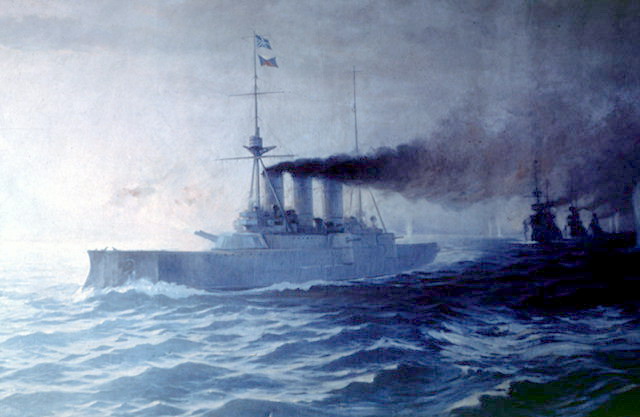
Naval Battle of Elli
The naval campaigns of the Balkan Wars were of secondary importance to the land fighting. Of the Balkan allies, only Greece had a significant navy. The pride of the Greek fleet was the armored cruiser Georgios Averof. In addition the Greeks had 16 modern destroyers, 19 old torpedo boats, and a small submarine, the Delphin. The Bulgarians had only six torpedo boats and a gunboat, the Nadezhda. All of the Bulgarian vessels operated only in the Black Sea. The Serbs and Montenegrins had no navies. The Ottomans had a number of older warships, including two armored cruisers, six armored ships, 11 torpedo destroyers, and 30 torpedo ships. Its modern vessels were the light cruiser Hamidiye and the armored cruiser Mecidiye.
The Greek navy assumed two main objectives. The first was to blockade the Ottoman coast and to contain the Ottoman navy in the Dardanelles and thus prevent the transport of Ottoman reinforcements from Anatolia to the Balkan Fronts. This was a major factor in Bulgarian calculations for an alliance with the Greeks. The second Greek naval objective was the seizure of the Aegean Islands from the Ottomans. In these two tasks, the Greeks succeeded. By the end of 1912, the Greeks had taken all of the Aegean Islands except Samos, which they occupied in March 1913. The Greeks also used their navy and merchant marine to transport Bulgarian troops to Dedeagach and Serbian troops to San Giovanni di Medua, (Albanian: Shengjin) Albania.
The largest naval engagement of the Balkan Wars occurred on December 16, 1912, at the Dardanelles. At that time Greeks defeated an Ottoman attempt to break out into the Aegean. A second attempt two days later also failed. Neither fleet suffered extensive damage, but the Greeks managed to contain the Ottomans in the Dardanelles.
Georgios Averof as a floating museum in Palaio Faliro, Athens
Ottoman defeats in the Italo-Turkish War and the First Balkan War prompted a coup d’état in the Ottoman Empire on January 23, 1913 by the leading members of the CUP [Committee of Union and Progress] movement, ending four years of political stalemate following the exile of Abdülhamid II. This consolidation of power created a more efficient environment for naval expansion, which was a matter that the leaders of the CUP energetically pursued, especially due to the poor performance of the Ottoman fleet in the First Balkan War. At the Battle of Elli on December 16, 1912, the Greek armored cruiser Averof alone outfought the battleships Barbaros Hayreddin, Torgut Reis, Mesudiye, and Asar-i Tevfik and, using superior tactics and speed, crossed the Ottoman “T” and forced them to disengage.
Despite the overall Greek success, the Ottomans did enjoy some successes with their navy. Naval fire from Ottoman warships in both the Black Sea and the Sea of Marmara helped to thwart the Bulgarian attack on the Chataldzha lines on November 17, 1912, and thus prevent the Bulgarian occupation of Constantinople.
The British-built protected cruiser Hamidiye.
Also the Ottoman cruiser Hamidiye managed to elude the Greek blockade of the Dardanelles on December 22, 1912. It proceeded to cruise the Mediterranean. It sunk the Greek auxiliary cruiser Makedonia in Syra harbor in the Cyclades on January 15 and attacked a Greek transport ship carrying Serbian troops at San Giovanni di Medua, Albania, on March 18, 1913, causing heavy casualties.
Some warships acquired by Abdülhamid II’s contract-as-compensation program proved to be modern and useful units that saw service in World War I. One of these was the protected cruiser Hamidiye (originally named Abdülhamid II), ordered from Armstrong Whitworth & Co. in Newcastle upon Tyne in the spring of 1900. Great Britain was another nation owed money due to the late 19th century uprisings (for the technical specifications of Hamidiye, see Plate A). Hamidiye was originally part of a modernization plan developed by Ottoman admirals in 1897 that envisioned the modernization of several old ironclads and the acquisition of two new battleships, two armored cruisers, two protected cruisers, and two light cruisers. The modernized Mesudiye, Asar-i Tevfik, a few other reconstructed older vessels, and Hamidiye were the only ships of this plan that Abdülhamid II approved funding for with the exception of a second protected cruiser.
While the Hamidiye’s exploits heartened the Ottomans, they had little effect on the outcome of the war.
Hamidiye was laid down in the Elswick yard of Armstrong Whitworth in April 1902, launched on September 25, 1903, and commissioned on April 27, 1904. She was typical of British protected cruisers of the time and was the first useful modern unit acquired by the Ottoman Navy in the 20th century. Hamidiye and her dynamic commander, Captain Rauf Orbay, gained international attention during the First Balkan War when they undertook a four-month raid throughout the Mediterranean, Adriatic, and Red Seas, bombarding Greek and Serbian ground installations and sinking seven Greek merchantmen. Hamidiye was a relatively well-maintained warship but age and heavy use had taken its toll on her machinery and by fall 1914 she could make only 16 knots. Nevertheless, she served as an effective convoy escort, sailing alongside Yavuz and Midilli during the early months of the war until her low speed made her too vulnerable to the new Russian destroyers and dreadnoughts entering service in 1915. She was brought back into service in the spring of 1918, after a lengthy refit, and conducted several operations with Yavuz along the Russian coast.